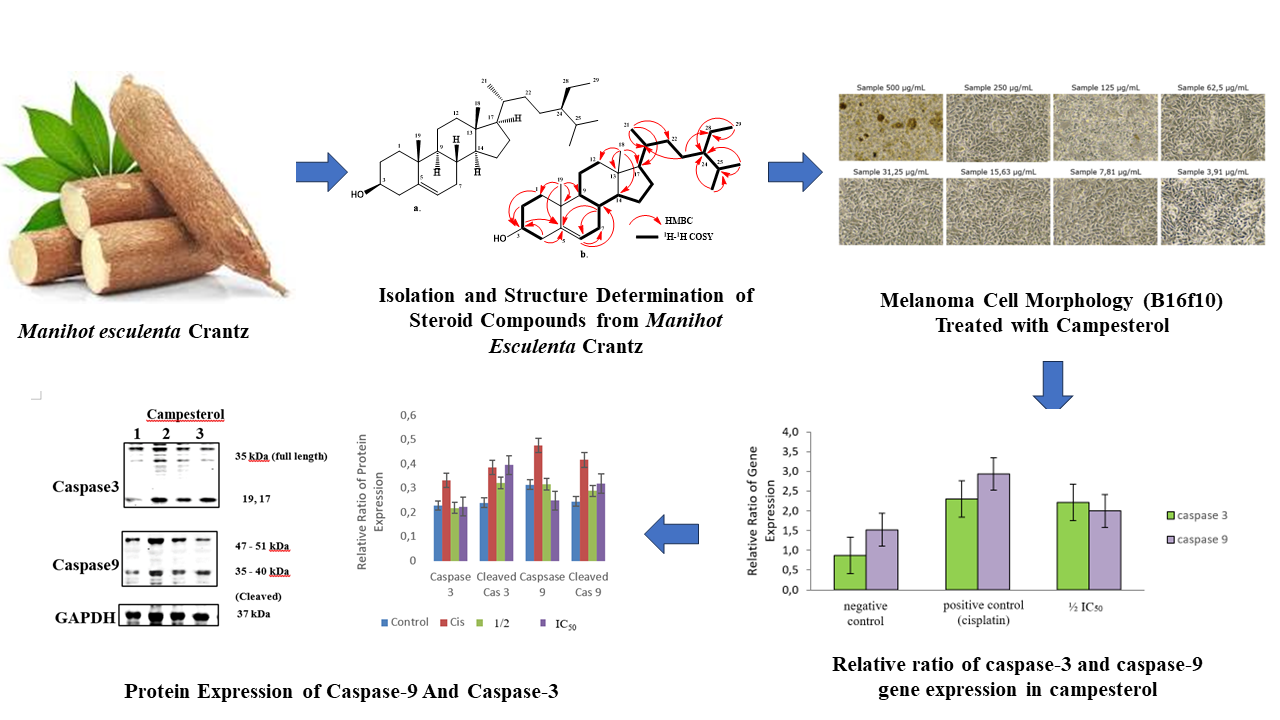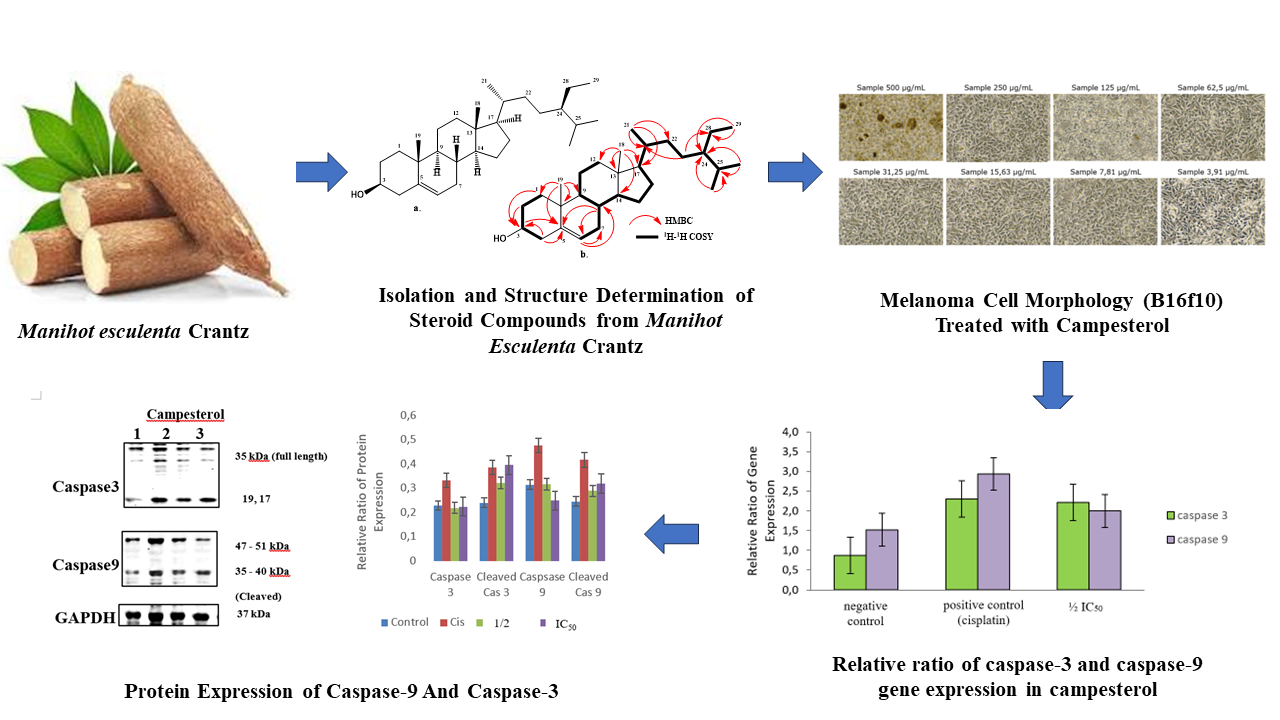Steroid Compounds of Manihot Esculenta Crantz Var. Sao Pedro Petro (Tuber) and Their Cytotoxic Effects on Melanoma Cancer Cells (B16-F10)
DOI:
https://doi.org/10.48048/tis.2024.7591Keywords:
Apoptosis, Manihot esculenta Crantz, Melanoma, SteroidsAbstract
The pharmacological research of Manihot esculenta has stated the potential present as an interesting cytotoxic activity caused by several compounds contained in this species. However, the research on Melanoma Malignant cells (B16-F10 cancer cells) has never been studied. In this study, the steroid compounds isolated from the tuber of Sao Pedro Petro (1 variety of species M. esculenta Crantz) were studied in vitro and further evaluated using the western blot technique. Three steroid compounds, namely β-sitosterol (1), Campesterol (2), and Cholesterol (3), were obtained from the n-hexane extract of fresh Cassava tubers (Manihot esculenta Crantz). The chemical structures of compounds 1 - 3 were determined through various spectroscopic techniques such as HR-TOFMS, and NMR (1H, 13C, DEPT 135 °, HMQC, HMBC, 1H-1H COSY), along with a comparison to previously reported spectral data. Additionally, the apoptotic signaling pathway was investigated using RT-qPCR and western blot analysis. Among the 3 compounds, Campesterol (2) exhibited the highest IC50 value and demonstrated significant inhibition of B16-F10 cell proliferation by inducing apoptosis through caspase-3 activation. In conclusion, our study is the first to show that steroid compounds isolated from M. esculenta have activity against B16-F10 cells. This provides insight that steroids have the potential as chemopreventive agents to treat melanoma skin cancer.
HIGHLIGHTS
- Three steroid compounds, namely β-sitosterol, campesterol, and cholesterol, were isolated from the n-hexane extract of fresh cassava tubers (Manihot esculenta Crantz) and campesterol exhibited the highest cytotoxic activity against B16-F10 melanoma cells, with an IC50 value of 160.4 µg/mL
- Campesterol induced apoptosis in B16-F10 melanoma cells through caspase-3 activation
- Treatment with campesterol led to noticeable alterations in cell morphology, including changes in shape, size, and other visible characteristics, further supporting its cytotoxic effects on melanoma cells
- The research's novelty lies in its exploration of previously unreported steroid compounds from cassava tubers, particularly campesterol, and their cytotoxic effects on melanoma cells, along with insights into the underlying mechanisms of action
- These findings contribute to the growing body of knowledge on natural compounds with potential therapeutic applications in cancer treatment
GRAPHICAL ABSTRACT

Downloads
Metrics
References
SP Wooding and CN Payahua. Ethnobotanical diversity of cassava (Manihot esculenta Crantz) in the Peruvian Amazon. Diversity 2022; 14, 252.
SK Muiruri, VO Ntui, L Tripathi and JN Tripathi. Mechanisms and approaches towards enhanced drought tolerance in cassava (Manihot esculenta). Curr. Plant Biol. 2021; 28, 100227.
W Shebaby, A Elias, M Mroueh, B Nehme, NDE Jalbout, R Iskandar, JC Daher, M Zgheib, P Ibrahim, V Dwairi, JM Saad, RI Taleb and CF Daher. Himachalol induces apoptosis in B16-F10 murine melanoma cells and protects against skin carcinogenesis. J. Ethnopharmacol. 2020; 253, 112545.
I Boukhers, F Boudard, S Morel, A Servent, K Portet, C Guzman, M Vitou, J Kongolo, A Michel and P Poucheret. Nutrition, healthcare benefits and phytochemical properties of cassava (Manihot esculenta) leaves sourced from three countries (Reunion, Guinea, and Costa Rica). Foods 2022; 11, 2027.
M Jampa, K Sutthanut, N Weerapreeyakul, W Tukummee, J Wattanathorn and S Muchimapura. Multiple bioactivities of Manihot esculenta leaves: Uv Filter, anti-oxidation, anti-melanogenesis, collagen synthesis enhancement, and anti-adipogenesis. Molecules 2022; 27, 1556.
D Widiastuti, AH Mulyati, E Herlina, S Warnasih, T Triastinurmiatiningsih and S Unang. Cytotoxic effects of cassava (Manihot esculenta Crantz), Adira-2, karikil and sao pedro petro varieties against P-388 murine leukemia cells. Res. J. Chem. Environ. 2018; 22, 206-8.
D Widiastuti, SE Sinaga, S Warnasih, E Pujiyawati, S Salam and WE Putra. Identification of active compounds from Averrhoa bilimbi L. (Belimbing Wuluh) flower using LC-MS and antidiabetic activity test using in vitro and in silico Approaches. Trends Sci. 2023; 20, 6761.
D Widiastuti, S Salam, D Haneti, R Lesmana, MA Nafiah and U Supratman. Flavonoid from the Sao Pedro Petro of tubers of cassava (Manihot esculenta Crantz). Res. J. Chem. Environ. 2019; 23, 111-3.
SE Sinaga, FF Abdullah, U Supratman, T Mayanti and R Maharani. Isolation and structure determination of stigmaterol from the stem bark of lansium domesticum Corr. Cv. Kokossan. Chim. Nat. Acta 2022; 10, 106-11.
S Chummun and NR McLean. The management of malignant skin cancers. Surgery 2017; 35, 519-24.
M Potez, V Trappetti, A Bouchet, C Fernandez-Palomo, E Güç, WW Kilarski, R Hlushchuk, J Laissue and V Djonov. Characterization of a B16-F10 melanoma model locally implanted into the ear pinnae of C57BL/6 mice. PLos One 2018; 13, e0206693.
Y Harada, Y Kizuka, Y Tokoro, K Kondo, H Yagi, K Kato, H Inoue, N Taniguchi and I Maruyama. N-glycome inheritance from cells to extracellular vesicles in B16 melanomas. FEBS Lett. 2019; 593, 942-51.
JO Pinho, M Matias, V Marques, C Eleutério, C Fernandes, L Gano, JD Amaral, E Mendes, MJ Perry, JN Moreira, G Storm, AP Francisco, CMP Rodrigues and MM Gaspar. Preclinical validation of a new hybrid molecule loaded in liposomes for melanoma management. Biomed. Pharmacother. 2023; 157, 114021.
T Krajnović, D Drača, GN Kaluđerović, D Dunđerović, I Mirkov, LA Wessjohann, D Maksimović-Ivanić and S Mijatović. The hop-derived prenylflavonoid isoxanthohumol inhibits the formation of lung metastasis in B16-F10 murine melanoma model. Food Chem. Toxicol. 2019; 129, 257-68.
JM Estrela, R Salvador, P Marchio, SL Valles, R López-Blanch, P Rivera, M Benlloch, J Alcácer, CL Pérez, JA Pellicer and E Obrador. Glucocorticoid receptor antagonism overcomes resistance to BRAF inhibition in BRAFV600E-mutated metastatic melanoma. Am. J. Canc. Res. 2019; 9, 2580-98.
GK Couto, NV Segatto, TL Oliveira, FK Seixas, KM Schachtschneider and T Collares. The melding of drug screening platforms for melanoma. Front. Oncol. 2019; 9, 512.
T Komel, M Bosnjak, SK Brezar, MD Robertis, M Mastrodonato, G Scillitani, G Pesole, E Signori, G Sersa and M Cemazar. Gene electrotransfer of IL-2 and IL-12 plasmids effectively eradicated murine B16.F10 melanoma. Bioelectrochemistry 2021; 141, 107843.
F Mirzavi, M Barati, A Soleimani, R Vakili-Ghartavol, MR Jaafari and M Soukhtanloo. A review on liposome-based therapeutic approaches against malignant melanoma. Int. J. Pharm. 2021; 599, 120413.
SE Sinaga, M Fajar, T Mayanti and U Supratman. Bioactivities screening and elucidation of terpenoid from the stembark extracts of lansium domesticum Corr. cv. Kokosan (Meliaceae). Sustainability 2023; 15, 2140.
D Widiastuti, S Salam, D Haneti and RLU Supratman. Cytitoxic activity from the tuber of cassava (Manihot esculenta crantz) against servical hela cancer lines. Int. J. Recent Tech. Eng. 2019; 8, 243-4.
Y Bodurlar and M Caliskan. Inhibitory activity of soybean (Glycine max L. Merr.) cell culture extract on tyrosinase activity and melanin formation in alpha-melanocyte stimulating hormone-induced B16-F10 melanoma cells. Mol. Biol. Rep. 2022; 49, 7827-36.
HJ Han, SK Park, JY Kang, JM Kim, SK Yoo and HJ Heo. Anti-melanogenic effect of ethanolic extract of sorghum bicolor on IBMX-induced melanogenesis in B16/F10 melanoma cells. Nutrients 2020; 12, 832.
S Susianti, R Lesmana, S Salam, E Julaeha, YS Pratiwi, N Sylviana, H Goenawan, A Kurniawan and U Supratman. The effect of nutmeg seed (M. fragrans) extracts induces apoptosis in melanoma maligna cell’s (B16-F10). Indonesian Biomed. J. 2021; 13, 68-74.
T Kim, KB Kim and CG Hyun. A 7-Hydroxy 4-methylcoumarin enhances melanogenesis in b16-f10 melanoma cells. Molecules 2023; 28, 3039.
EK Sutedja, D Amarassaphira, H Goenawan, YS Pratiwi, N Sylviana, B Setiabudiawan, O Suwarsa, RTD Judistiani, U Supratman and R Lesmana. Calcitriol inhibits proliferation and potentially induces apoptosis in B16-F10 cells. Med. Sci. Mon. Basic Res. 2022, 28, e935139.
CC Jan-Michael and CY Ragasa. Structure elucidation of β-stigmasterol and β-sitosterol from Sesbania grandifora [Linn.] Pers. and β-carotene from Heliotropium indicum Linn. by NMR spectroscopy. Kimika 2004; 20, 5-12.
E Hadrian, AP Sari, T Mayanti, D Harneti, R Maharani, D Darwati, K Farabi, U Supratman, C Waranmaselembun and S Salam. Steroids from Atactodea striata and their cytotoxic activity against MCF-7 Breast Cancer Cell Lines. Indonesian J. Chem. 2022; 23, 200-9.
MY Morad, H El-Sayed, MF El-Khadragy, A Abdelsalam, EZ Ahmed and AM Ibrahim. Metabolomic profiling, antibacterial, and molluscicidal properties of the medicinal plants Calotropis procera and Atriplex halimus: In silico molecular docking study. Plants 2023; 12, 477.
S Nikita, K Thakur, A Chhokar, J Yadavi, T Tripathi, Jadli, M Bhat, Anjali, A Kumar, RH Narula, R Hasija, G Pankaj, A Khurana, A Bharti and TA Chandra. Evaluation of therapeutic potential of selected plant-derived homeopathic medicines for their action against cervical cancer. Homeopathy 2023; 112, 262-74.
S Pathania, P Bansal, P Gupta and RK Rawal. Genus calotropis: A hub of medicinally active phytoconstituents. Curr. Tradit. Med. 2019; 6, 312-31.
RK Saini, YS Keum, M Daglia and KR Rengasam. Dietary carotenoids in cancer chemoprevention and chemotherapy: A review of emerging evidence. Pharmacol. Res. 2020; 157, 104830.
MI Rushdi, IAM Abdel-Rahman, EZ Attia, H Saber, AA Saber, G Bringmann and UR Abdelmohsen. The biodiversity of the genus dictyota: Phytochemical and pharmacological natural products prospectives. Molecules 2022; 27, 672.
J Wu, J Ye, W Kong, S Zhang and Y Zheng. Programmed cell death pathways in hearing loss: A review of apoptosis, autophagy and programmed necrosis. Cell Prolif. 2020; 53, e12915.
M Jiang, L Qi, L Li and Y Li. The caspase-3/GSDME signal pathway as a switch between apoptosis and pyroptosis in cancer. Cell Death Discov. 2020; 28, 112.
S Umar, R Soni, SD Durgapal, S Soman and S Balakrishnan. A synthetic coumarin derivative (4 ‐ flourophenylacetamide ‐ acetyl coumarin) impedes cell cycle at G0/G1 stage , induces apoptosis, and inhibits metastasis via ROS ‐ mediated p53 and AKT signaling pathways in A549 cells. J. Biochem. Mol. Toxicol. 2020; 34, e22553.
V Singh, A Khurana, U Navik, P Allawadhi, KK Bharani and R Weiskirchen. Apoptosis and pharmacological therapies for targeting thereof for cancer therapeutics. Sci 2022; 4, 15.
M Hadzic, Y Sun, N Tomic and E Tsirvouli, M Kuiper and L Pojskic. Halogenated boroxine increases propensity to apoptosis in leukemia (UT-7) but not non-tumor cells in vitro. FEBS Open Bio 2023; 13, 143-53.
K Fettucciari, F Marguerie, A Fruganti, A Marchegiani and A Spaterna, S Brancorsini, P Marconi and G Bassotti. Clostridioides difficile toxin B alone and with pro ‑ inflammatory cytokines induces apoptosis in enteric glial cells by activating three different signalling pathways mediated by caspases, calpains and cathepsin B. Cell. Mol. Life Sci. 2022; 79, 442.
WE Yang, YT Chen, CW Su, MK Chen, CM Yeh, YL Chen, MY Tsai, SF Yang and CW Lin. Hispolon induces apoptosis in oral squamous cell carcinoma cells through JNK/HO-1 pathway activation. J. Cell. Mol. Med. 2023; 27, 1250-60.
LE Araya, IV Soni, JA Hardy and O Julien. Deorphanizing caspase-3 and caspase-9 substrates in and out of apoptosis with deep substrate profiling. ACS Chem. Biol. 2022; 16, 2280-96.
MA Wride, FC Mansergh, S Adams, R Everitt, SE Minnema, E Rancourt and MJ Evans. Expression profiling and gene discovery in the mouse lens. Mol. Vis. 2003; 22, 360-96.

Downloads
Published
How to Cite
Issue
Section
License
Copyright (c) 2023 Walailak University

This work is licensed under a Creative Commons Attribution-NonCommercial-NoDerivatives 4.0 International License.






